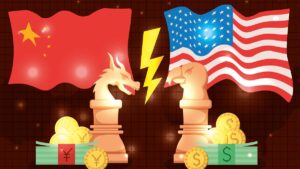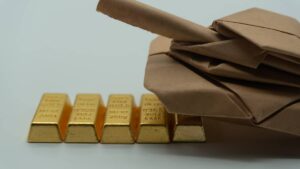After Russia, Ukraine and the short squeeze, can nickel return to normal?

Pic: Getty
Nickel makes up less than 1% of Australia’s dominant mining export earnings, and at a global market size of ~2.5Mt is more a curiosity to the average punter than a household name.
But it has taken centre stage in recent days, becoming the most engrossing story in the world of natural resources.
Oil and coal prices are also on a tear after sanctions and boycotts against Russia following its hostile and tragic invasion of Ukraine.
But neither have seen circumstances as strange as the squeeze that sent nickel prices up more than 60% in two straight trading days to levels twice as high as the record seen in its last boom 15 years ago.
After the benchmark three month contract on the London Metals Exchange ran from under US$30,000/t on Monday to a near record close of US$48,063/t, it then jumped more than 100% to over US$100,000/t on Tuesday afternoon in Asian trade before settling back to US$82,000/t before LME took the extraordinary step of suspending the market.
“I haven’t seen it in my career,” David Southam, the boss of local nickel miner Mincor Resources (ASX:MCR) said.
“Let alone nickel price going up one night 63% and then again up however many per cent it went up before it got suspended.
“I don’t think I’ve really seen that in any commodity, those type of movements.”
Will these wild moves be corrected soon? Many experts think it will once the short squeeze plays out.
World’s biggest nickel player in a spot of bother
The fall guys for that short squeeze appear to be Tsingshan and its founder Xiang Guangda.
Xiang and Tsingshan were short a reported 100,000t on the LME, a mix of hedges against future production and bets on the nickel price going down.
Prices had already been rising steadily this year, hitting 11-year highs last month on low stockpiles and demand from the growing EV battery market. Nickel stocks held through the LME are at just 75,012t, the lowest level since 2019.
The idea that Russian nickel supply could be cut off amid its invasion of Ukraine, almost a fifth of the global refined nickel trade, has sent prices even higher since the start of the conflict.
As they rose shorters were forced to buy to limit their losses but found it increasingly difficult to find sellers, triggering a Catch-22 style market implosion.
The LME’s suspension of its nickel futures will allow banks and traders more time to raise cash for margin calls and potentially take some heat out of the overcooked market.
Not only has trade been suspended, but all trades on Tuesday have been cancelled with quoted prices returning to Monday’s close.
It remains unknown how long the market will stay shut, but it is not expected to be before tomorrow morning London time and a string of measures to contain price volatility could be in place, including price bands common to Chinese futures markets.
Tsingshan could be hit for $8 billion: WSJ
The Wall Street Journal fingered the potential trading losses incurred by Tsingshan on its contracts at US$8 billion, a number also reported in Chinese media, where founder Xiang has spoken publicly to try douse some of the flames.
“Relevant government departments and leaders are all very supportive of Tsingshan. Tsingshan is a solid Chinese enterprise and our positions and operations do not have problems,” he reportedly told local financial news provider Xicai.
That has raised some questions for an Australian company with deep ties to the Chinese giant.
Nickel Mines (ASX:NIC), an emerging Indonesian nickel pig iron producer which says its expansion plans over the next two years will make it a larger producer than mining giant BHP, is closely linked to Chinese nickel and stainless steel behemoth Tsingshan.
NIC called a trading halt after its shares tanked by 22.7%, saying it was responding to a price query sent by the ASX.
Shanghai Decent, a subsidiary of Tsingshan, owns an 18.7% stake in NIC.
But its roots run deeper.
Shanghai Decent’s cookie-cutter model of building rotary kiln electric furnace nickel pig iron plants is the foundation of Nickel Mines’ expansion.
Tsingshan’s in-country team builds the plants which Nickel Mines then raises capital to take a majority stake in, selling Tsingshan the offtake and keeping it on as a minority partner.
The Hengjaya and Ranger plants are already up and running, with Nickel Mines looking to more than double production over the next two years by opening the Angel and Oracle plants in 2022 and 2023 respectively.
Nickel Mines was in fantastic financial health before this weekend, delivering a US$176.0M profit after tax in 2021 and issuing around $100 million in dividends to shareholders.
But the disruption in the nickel market has brought its high flying partner down to earth.
Nickel Mines responds
Nickel Mines recovered most of those losses after reassuring the market its business with Tsingshan was all sweet in a response to a price query from the ASX.
It spent yesterday in discussions with Tsingshan and Shanghai Decent, saying “the Company’s operations at the Hengjaya Nickel and Ranger Nickel projects are unaffected, as is commissioning at the Angel Nickel project and construction at the Oracle Nickel project.”
“Tsingshan have firmly assured the Company that they have no intention of selling any shares that it holds in the Company,” Nickel Mines said in its response.
It said there were no changes in Tsingshan’s commitment to take all the offtake from its existing projects and take Nickel Mines shares in a placement to fund its purchase of 70% of the Oracle nickel project.
“Tsingshan remains the world’s largest stainless steel and nickel producer with its operations generating revenues of 352B RMB (US$~$56B) in 2021,” the company said.
“Tsingshan’s operations remain robust and unaffected with the Group having strong confidence in its ability to manage its current market position.”
Nickel Mines share price today:
Prices ‘unsustainable’
The history of nickel price moves shows they can be short and violent.
In 2007, the last time prices came close to current levels, they spiked above US$50,000/t in April and May before being back below US$30,000/t within three months.
Southam described the recent price movement as a “black run ski slope” that was unsustainable.
“There’s definitely a shortness of nickel supply and the price has reacted positively. But I don’t think it does the industry any favours, and I don’t take too much notice of where that nickel price ended up,” he said.
“Because I know it’s not sustainable, it’s not healthy. And you know, it’s not often you’ve got the CEO of a mining company saying the price is too high, you don’t often hear that.”
Contract prices are generally based on month averages, so any impact on miners’ earnings will take a while to be discovered.
Southam expects nickel will eventually return to the positive but steady trajectory it was on before the conflict began.
The price of the commodity, used in stainless steel and increasingly in lithium ion batteries for electric vehicles, had already risen around 30% between the start of 2021 and the Russian invasion of Ukraine.
“I am the worst nickel price forecaster in the world because I’m a conflicted witness,” Southam said.
“But we put in our feasibility study (a price of) $22,500 Aussie per tonne. Before this it was trading over $40,000 Aussie per tonne.
“And that’s probably an area where I’d say it would settle. If you compared it at US$100,000 per tonne, it’s a silly number and it’s not even worth calculating.”
Mincor is set to become Australia’s next nickel producer, with ore from its revived Kambalda operations now being sent to BHP’s (ASX:BHP) local Nickel West concentrator for processing.
Concentrate production is due to start in the June quarter.
Selected ASX nickel stocks
Scroll or swipe to reveal table. Click headings to sort.
| CODE | COMPANY | PRICE | 1 WEEK RETURN % | 1 MONTH RETURN % | 6 MONTH RETURN % | 1 YEAR RETURN % | MARKET CAP |
|---|---|---|---|---|---|---|---|
| PUR | Pursuit Minerals | 0.02 | -5% | -13% | -57% | -67% | $ 18,910,983.88 |
| MAN | Mandrake Res Ltd | 0.045 | 0% | -8% | -22% | -70% | $ 20,727,637.01 |
| CHN | Chalice Mining Ltd | 7.89 | 1% | 2% | 12% | 100% | $ 2,616,523,003.38 |
| SI6 | SI6 Metals Limited | 0.009 | -10% | -10% | -36% | -53% | $ 12,853,295.87 |
| CNJ | Conico Ltd | 0.011 | 0% | -21% | -83% | -59% | $ 11,002,363.61 |
| ESR | Estrella Res Ltd | 0.033 | 32% | 0% | -20% | -51% | $ 38,421,809.28 |
| AOU | Auroch Minerals Ltd | 0.125 | 16% | 0% | -29% | -43% | $ 46,969,233.87 |
| QPM | Queensland Pacific | 0.14 | -3% | -18% | -36% | 69% | $ 216,035,838.34 |
| CTM | Centaurus Metals Ltd | 1.28 | 2% | 5% | 24% | 80% | $ 539,257,154.70 |
| LTR | Liontown Resources | 1.535 | 1% | 5% | 50% | 268% | $ 3,189,687,663.09 |
| AZS | Azure Minerals | 0.41 | 8% | 0% | 9% | 32% | $ 125,847,967.01 |
| DEV | Devex Resources Ltd | 0.445 | 22% | 5% | 39% | 102% | $ 141,382,786.05 |
| IPT | Impact Minerals | 0.016 | 33% | 23% | 33% | -30% | $ 32,380,718.70 |
| SBR | Sabre Resources | 0.005 | 11% | 0% | 25% | 0% | $ 8,139,254.60 |
| BSX | Blackstone Ltd | 0.45 | 0% | -27% | -5% | -5% | $ 202,318,904.25 |
| PGM | Platina Resources | 0.053 | 4% | 4% | -27% | 23% | $ 22,587,881.78 |
| ARV | Artemis Resources | 0.07 | 0% | -4% | -26% | 253% | $ 97,183,168.88 |
| PNN | PepinNini Minerals | 0.415 | -2% | -8% | 38% | -1% | $ 23,875,142.46 |
| NIC | Nickel Mines Limited | 1.405 | -9% | -3% | 41% | 19% | $ 3,869,148,129.15 |
| OZL | OZ Minerals | 26.06 | 5% | 3% | 11% | 8% | $ 8,677,822,984.50 |
| LIT | Lithium Australia NL | 0.11 | 0% | -8% | -8% | 22% | $ 108,419,912.58 |
| HXG | Hexagon Energy | 0.055 | 2% | -2% | -31% | -12% | $ 23,213,800.12 |
| AVL | Aust Vanadium Ltd | 0.036 | 0% | -14% | 64% | -45% | $ 118,807,556.94 |
| AUZ | Australian Mines Ltd | 0.165 | 3% | -13% | -34% | 80% | $ 73,160,808.49 |
| SLZ | Sultan Resources Ltd | 0.16 | 0% | 0% | 3% | -16% | $ 13,325,502.24 |
| HNR | Hannans Ltd | 0.032 | -9% | -20% | 363% | -14% | $ 80,794,415.76 |
| AQD | Ausquest Limited | 0.017 | -6% | -11% | -15% | 305% | $ 14,010,536.79 |
| RXL | Rox Resources | 0.41 | -4% | -4% | -1% | -15% | $ 67,576,378.80 |
| ARL | Ardea Resources Ltd | 0.785 | 15% | 16% | 86% | -28% | $ 124,610,262.42 |
| GAL | Galileo Mining Ltd | 0.22 | 13% | 19% | -25% | 62% | $ 37,892,071.13 |
| SRL | Sunrise | 1.9 | 0% | 4% | 10% | -10% | $ 165,706,497.36 |
| POS | Poseidon Nick Ltd | 0.093 | 0% | -7% | -19% | -19% | $ 272,692,397.81 |
| G88 | Golden Mile Res Ltd | 0.061 | 9% | 13% | 0% | 39% | $ 10,727,136.34 |
| S2R | S2 Resources | 0.175 | -3% | -3% | 52% | 17% | $ 58,801,851.08 |
| MCR | Mincor Resources NL | 2.11 | 6% | 24% | 61% | 13% | $ 992,912,088.00 |
| LEG | Legend Mining | 0.07 | 3% | -1% | -7% | 118% | $ 187,349,229.03 |
| RFR | Rafaella Resources | 0.056 | -2% | -15% | -38% | -44% | $ 12,676,367.71 |
| SRI | Sipa Resources Ltd | 0.054 | -2% | 6% | -10% | -51% | $ 11,071,339.36 |
| CWX | Carawine Resources | 0.22 | 5% | 29% | 7% | 4% | $ 30,323,556.34 |
| MOH | Moho Resources | 0.045 | -4% | -17% | -26% | -39% | $ 5,725,662.54 |
| BUX | Buxton Resources Ltd | 0.115 | 10% | 35% | 55% | -43% | $ 14,966,097.52 |
| IGO | IGO Limited | 13.07 | 12% | 8% | 38% | 69% | $ 9,685,455,328.27 |
| STK | Strickland Metals | 0.06 | 3% | -6% | 54% | 105% | $ 76,790,370.00 |
| PAN | Panoramic Resources | 0.32 | 19% | 28% | 56% | 180% | $ 635,783,341.24 |
| BHP | BHP Group Limited | 48.49 | 4% | -1% | 17% | 146% | $ 245,674,544,410.70 |
| SGQ | St George Min Ltd | 0.048 | 14% | -26% | -29% | -2% | $ 28,281,164.98 |
| CZN | Corazon Ltd | 0.035 | 17% | 3% | -5% | -51% | $ 12,471,702.08 |
| VMC | Venus Metals Cor Ltd | 0.185 | 6% | -12% | 9% | -36% | $ 27,949,556.36 |
| ALY | Alchemy Resource Ltd | 0.012 | -8% | -8% | -18% | -3% | $ 11,428,138.68 |
| GBR | Greatbould Resources | 0.15 | 3% | 3% | -6% | -12% | $ 53,585,371.35 |
| BOA | Boadicea Resources | 0.2 | 0% | -11% | 8% | 317% | $ 15,151,479.53 |
| ESS | Essential Metals Ltd | 0.355 | 0% | -25% | 92% | -9% | $ 80,605,382.88 |
| NKL | Nickelxltd | 0.145 | 4% | 0% | -34% | 255% | $ 8,025,750.00 |
| WSA | Western Areas Ltd | 3.52 | 5% | 1% | 14% | 0% | $ 1,112,885,316.30 |
| GME | GME Resources Ltd | 0.075 | 27% | 12% | 29% | 50% | $ 42,767,334.86 |
| GSR | Greenstone Resources | 0.036 | 3% | -3% | 38% | 14% | $ 34,825,240.18 |
| MHK | Metalhawk. | 0.29 | 5% | 5% | 57% | 71% | $ 13,974,233.35 |
Remembering the tin crisis
The last time anything like this happened was back in 1985-86, when the LME suspended its tin contract.
In that case the International Tin Council ran out of money and went belly-up, no longer able to hoover up stock from a heavily oversupplied market.
READ: ALL YOU NEED TO KNOW ABOUT ASX TIN STOCKS.
Prices tanked, the market was suspended and it took years to rebuild.
Fastmarkets head of battery and base metals research Will Adams says in this case prices are likely to fall back to normal levels “before too long” with this week’s unheard of run up “likely to be a spike”.
Adams was predicting a 93,000t deficit for the market before the Russian invasion of Ukraine, something that could grow to the 200,000t mark if Russia’s nickel does not make to the market through countries where companies are not boycotting or it enacts its own export ban.
However, he expects prices to return to their previous path.
“There could be some some supply issues and I think had Russia not invaded Ukraine, and things had got back to normal and they actually removed their troops from the border, then I think we would have seen prices sort of drift back to the $20,000/t mark,” he told Stockhead.
“We’re probably going to settle somewhere in the US$25,000-30,000 area, once things are returning to normal and that is if Russia doesn’t ban exports of its commodities.”
Battery questions
Rising prices for electric vehicle inputs like nickel have stirred concerns of potential ‘demand destruction’ with electric vehicle sales continuing to rise and require more raw materials.
But Southam said those are alarmist, noting the short-term nature of the movement.
“The nickel price has gone up there for two days, it’s all off factors outside of an orderly market, if you like,” he said.
“So my view is that it will trade back down to where it was prior to these squeezes, which is a very healthy nickel price.”
“The market will head back to normal once this very short term situation is settled.
“I don’t think you’ll find anyone that believes that these prices will be sustainable and therefore make it into the cost of producing an electric vehicle battery.”
Adams told Stockhead he’s more worried about lithium shortages than nickel shortages for battery makers.
While more expensive but higher range nickel-cobalt-manganese battery chemistries have seen competition from cheaper lithium-iron-phosphate models, Adams said NCM chemistries are still seeing “massive growth” in China.
Related Topics
UNLOCK INSIGHTS
Discover the untold stories of emerging ASX stocks.
Daily news and expert analysis, it's free to subscribe.
By proceeding, you confirm you understand that we handle personal information in accordance with our Privacy Policy.








